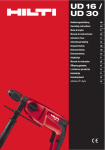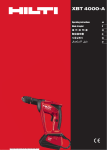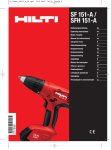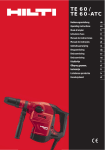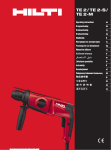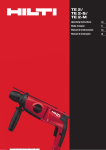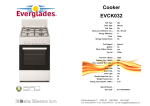Download Hilti 3497790 Use and Care Manual
Transcript
00_Cover_TE2_S_M_P1.qxd 09.11.2005 16:23 Uhr Seite 1 TE 2/TE 2-E/ TE 2-S/TE 2-M 7 TE 2 / TE 2-E Hilti Corporation 7a FL-9494 Schaan Tel.: +423 / 234 21 11 Fax: +423 / 234 29 65 www.hilti.com 7b 7 TE2-S 7a 7c 7b 7 TE2-M 7b 7c 1 1 1 2 2 9 de Operating instructions en Mode d’emploi fr Istruzioni d’uso it Gebruiksaanwijzing nl Manual de instruções pt Manual de instrucciones es Brugsanvisning da Käyttöohje fi Bruksanvisning no Bruksanvisning sv Οδηγιες χρησεως el Ръководство за обслужване bg Upute za uporabu hr Instrukcja obsługi pl Инструкция по зксплуатации ru Návod na obsluhu sk Navodila za uporabo sl Návod k obsluze cs Használati utasítás hu Kasutusjuhend et Lietoßanas pamåcîba lv Instrukcija lt zh 10 ja TE2-M 2 1 Hilti = registered trademark of Hilti Corp., Schaan W 2740 0805 10-Pos. 1 1 Printed in Liechtenstein © 2005 Right of technical and programme changes reserved S. E. & O. *376008* ko 1 376008 8 2 376008 / D 7a Bedienungsanleitung 00_Cover_TE2_S_M_P1.qxd 09.11.2005 16:23 Uhr Seite 5 1 2 TE2-M 1 2 6 1 4 TE2-M 2 TE 2 1 TE2-M 2 3 TE2-M 3 TE 2-S 5 6 7 9 1 TE 2-M 2 4 8 TE 2 / TE 2-E TE 2-S TE2-M 1 2 5b 5a 02_BA_TE2_S_M_P1_en.qxd 9.11.2005 11:33 Seite 11 TE 2/TE 2-E/TE 2-S/TE 2-M Rotary Hammer General information It is essential that the operating instructions are read before the tool is operated for the first time. In these operating instructions, this symbol indicates points of particular importance to safety. The instructions at these points must always be observed in order to avoid the risk of serious injury. Caution: high voltage Always keep these operating instructions together with the tool. Ensure that the operating instructions are with the tool when it is given to other persons. Operating controls Chuck release ring (TE 2-M) Function selector switch Control switch Forwards / reverse switch (TE 2 / TE 2-S / TE 2-M) Lockbutton Read the operating instructions before use. Return waste material for recycling The numbers refer to the illustrations. The illustrations can be found on the fold-out cover pages. Keep these pages open while you read the operating instructions. In these operating instructions, the power tool to which these operating instructions apply is referred to as “the tool”. Description Component parts Dust shield Chuck Side handle Type plate The TE 2 / TE 2-E / TE 2-S / TE 2-M is an electrically powered rotary hammer with pneumatic hammering mechanism designed for professional use. The following items are supplied: power tool, (quickrelease chuck TE 2-M), operating instructions, grease, toolbox. Contents General information Description Technical data Safety rules Before use Operation Drilling Forwards/reverse rotation Insert tools and accessories Care and maintenance Disposal Warranty Troubleshooting Declaration of conformity Page 11 11 13 14 15 16 16 17 17 17 18 18 19 19 – – – – – – The following conditions must always be observed when the tool is in use: The tool must be connected to an alternating current electric supply in compliance with the information given on the type plate. The tool is for hand-held use only. The tool must not be used in places where the surrounding conditions may present a risk of explosion. Changes or modifications to the tool are not permissible. To avoid the risk of injury, use only the genuine Hilti accessories and additional equipment specified for use with this tool. Observe the information printed in the operating instructions concerning operation, care and maintenance. The tool and its ancillary equipment may present hazards when used incorrectly by untrained personnel or when used not as directed. 11 02_BA_TE2_S_M_P1_en.qxd 9.11.2005 11:33 – The tool is intended for professional use.The tool may be operated, serviced and repaired only by authorized, trained personnel. This personnel must be informed of any special hazards that may be encountered. Main features of the tool Class II electrical protection (double insulated) Z Mechanical torque-limiting clutch Grip and side handle with vibration absorption TE-C chuck TE-C insert tool system Seite 12 Variable speed switch Rotary-only drilling mode Gearing and hammering mechanism with permanent grease lubrication Pivotable side handle (360°) Mechanical depth gauge Interface for quick-release chuck (TE 2-M) Precision hammering action (TE 2-S) High spindle speed without hammering action (TE 2-M) Lockbutton for sustained operation Right of technical changes reserved The tool is designed for the following uses: Use TE 2 / TE 2-E / TE 2-S / TE 2-M: Hammer drilling in concrete, masonry and natural stone TE 2-S: Drilling with precision hammering action in perforated brick, tiles and marble TE 2 / TE 2-E / TE 2-S: Drilling in wood, drywall panels and metal Required insert tools Diameter range Drill bits with TE-C connection end Drilling in concrete: – Short hammer drill bits Anchor holes of 4–22 mm dia. – Long hammer drill bits Through holes of 4–22 mm dia. Drill bits with TE-C connection end Drilling in brittle materials: – TE-C hammer drill bits Anchor holes of 4–22 mm dia. – Thin-barrel core bits Cutting sockets of 25–68 mm dia. Quick-release chuck with TE-C adaptor for insert tools with cylindrical shank or hexagonal shank for rotary-only drilling Wood drill bits 4–20 mm dia. Metal drill bits 3–13 mm dia. Hole saws 25–68 mm dia. TE 2-M: Drilling in wood, drywall panels, Interchangeable quick-release chuck tiles and metal for insert tools with cylindrical shank or hexagonal shank for rotary-only drilling: Wood drill bits 4–10 mm dia. in 2nd gear 10–20 mm dia. in 1st gear Metal/stepped drill bits 3– 8 mm dia. in 2nd gear 8–13 mm dia. in 1st gear Hole saws 25–68 mm dia. in 1nd gear 12 02_BA_TE2_S_M_P1_en.qxd 9.11.2005 11:33 Seite 13 Technical data Rated power Nominal voltage ✱ Nominal current input ✱ Mains frequency Weight of tool Dimensions (l×h×w) Minimum distance between wall and hole drilled Speed Hammering speed: Precision hammering action Full hammering action Single impact energy Nm (J): Precision hammering action Full hammering action Typical drilling performance in medium-hard B35 concrete Noise and vibration information (measured in accordance with EN 60745): Typical A-weighted sound power level (LwA): Typical A-weighted sound power level (LpA): 650 W 100 V 110 V 120 V 220 V 230 V 240 V 6.9 A 6.5 A 6.1 A 3.1 A 3.0 A 2.9 A 50–60 Hz 2.4 kg (TE 2 / TE 2-E / TE 2-S) 2.7 kg (TE 2-M) 352×203×89 mm (TE 2 / TE 2-E / TE 2-S) 360×203×89 mm (TE 2-M) 34 mm 0– 930 r.p.m. (hammer drilling) 0–1200 r.p.m. (in 1st gear TE2 / TE2-E / TE2-S / TE2-M) 0–2500 r.p.m. (in 2nd gear TE 2-M) 0–2600 blows/min. (TE 2-S) 0–4600 blows/min. (TE 2 / TE 2-E / TE 2-S / TE 2-M) 0.6 Nm (TE 2-S) 1.8 Nm (TE 2 / TE 2-E / TE 2-S / TE 2-M) 8 mm dia.: 550 mm/min 10 mm dia.: 500 mm/min 12 mm dia.: 400 mm/min 102 dB (A) 91dB (A) Wear ear protection! For the given sound power level as per EN 60745, the tolerance is 3 dB. Typical weighted vibration at the grips 11 m/s2 ✱ The tool is offered in different versions for various mains voltages. Please refer to the information on the type plate for the nominal voltage and nominal current input of your tool. 13 02_BA_TE2_S_M_P1_en.qxd 9.11.2005 11:33 Safety rules 1. General safety rules -WARNING- Read all instructions! Failure to follow all instructions listed below may result in electric shock, fire and/or serious injury. The term "power tool" in all of the warnings listed below refers to your mains operated (corded) power tool or battery operated (cordless) power tool. SAVE THESE INSTRUCTIONS 1.1 Work area a) Keep work area clean and well lit. Cluttered and dark areas invite accidents. b) Do not operate power tools in explosive atmospheres, such as in the presence of flammable liquids, gases or dust. Power tools create sparks which may ignite the dust or fumes. c) Keep children and bystanders away while operating a power tool. Distractions can cause you to lose control. 1.2 Electrical safety a) Power tool plugs must match the outlet. Never modify the plug in any way. Do not use any adapter plugs with earthed (grounded) power tools. Unmodified plugs and matching outlets will reduce risk of electric shock. b) Avoid body contact with earthed or grounded surfaces such as pipes, radiators, ranges and refrigerators. There is an increased risk of electric shock if your body is earthed or grounded. c) Do not expose power tools to rain or wet conditions. Water entering a power tool will increase the risk of electric shock. d) Do not abuse the cord. Never use the cord for carrying, pulling or unplugging the power tool. Keep cord away from heat, oil, sharp edges or moving parts. Damaged or entangled cords increase the risk of electric shock. e) When operating a power tool outdoors, use an extension cord suitable for outdoor use. Use of a cord suitable for outdoor use reduces the risk of electric shock. 1.3 Personal safety a) Stay alert, watch what you are doing and use common sense when operating a power tool. Do not use a power tool while you are tired or under the influence of drugs, alcohol or medication. A moment of inattention while operating power tools may result in serious personal injury. b) Use safety equipment. Always wear eye protection. Safety equipment such as dust mask, non-skid safety shoes, hard hat, or hearing protection used for appropriate conditions will reduce personal injuries. c) Avoid accidental starting. Ensure the switch is in the off position before plugging in. Carrying power 14 Seite 14 tools with your finger on the switch or plugging in power tools that have the switch on invites accidents. d) Remove any adjusting key or wrench before turning the power tool on. A wrench or a key left attached to a rotating part of the power tool may result in personal injury. e) Do not overreach. Keep proper footing and balance at all times. This enables better control of the power tool in unexpected situations. f) Dress properly. Do not wear loose clothing or jewellery. Keep your hair, clothing and gloves away from moving parts. Loose clothes, jewellery or long hair can be caught in moving parts. g) If devices are provided for the connection of dust extraction and collection facilities, ensure these are connected and properly used. Use of these devices can reduce dust related hazards. 1.4 Power tool use and care a) Do not force the power tool. Use the correct power tool for your application. The correct power tool will do the job better and safer at the rate for which it was designed. b) Do not use the power tool if the switch does not turn it on and off. Any power tool that cannot be controlled with the switch is dangerous and must be repaired. c) Disconnect the plug from the power source before making any adjustments, changing accessories, or storing power tools. Such preventive safety measures reduce the risk of starting the power tool accidentally. d) Store idle power tools out of the reach of children and do not allow persons unfamiliar with the power tool or these instructions to operate the power tool. Power tools are dangerous in the hands of untrained users. e) Maintain power tools. Check for misalignment or binding of moving parts, breakage of parts and any other condition that may affect the power tool's operation. If damaged, have the power tool repaired before use. Many accidents are caused by poorly maintained power tools. f) Keep cutting tools sharp and clean. Properly maintained cutting tools with sharp cutting edges are less likely to bind and are easier to control. g) Use the power tool, accessories and tool bits etc., in accordance with these instructions and in the manner intended for the particular type of power tool, taking into account the working conditions and the work to be performed. Use of the power tool for operations different from those intended could result in a hazardous situation. 1.5 Service a) Have your power tool serviced by a qualified repair person using only identical replacement parts. This will ensure that the safety of the power tool is maintained. 02_BA_TE2_S_M_P1_en.qxd 9.11.2005 11:33 2. Additional safety rules 2.1 Personal safety a) Wear ear protectors. Exposure to noise can cause hearing loss. b) Use auxiliary handles supplied with the tool. Loss of control can cause personal injury. c) Always hold the tool with both hands on the grips provided. Keep the grips dry, clean and free from oil and grease. d) Exercise your fingers during pauses between work to improve the blood circulation in your fingers. e) Avoid contact with rotating parts. Switch the tool on only once it has been brought into the working position close to the workpiece. f) Breathing protection must be worn when the tool is used without a dust removal system for work that creates dust. g) To avoid tripping and falling when working, always lead the sypply cord, extension cord and dust extraction hose away to the rear. h) When drilling or chiseling through-holes, check that no person is present in the danger area immediately behind the work surface. 2.2 Power tool use and care a) Secure the workpiece. Use clamps or a vice to hold the workpiece in place. The workpiece is thus held more securely than by hand and both hands remain free to operate the tool. b) Ensure that the insert tools used are equipped with the appropriate connection end system and that they are properly fitted and secured in the chuck. c) In the event of a power faillure, switch the tool off and unplug the supply cord. This prevents inadvertent starting when the power returns. d) In the event of an interruption in the electric supply and before laying the tool down each time, check that the lockbutton for sustained operation has been released. Release the lockbutton if necessary. Failure to observe this point could cause the tool to start unexpectedly when the power returns. e) Do not apply an excessive quantity of grease to the drill bit connection end. Excess grease may otherwise be forced out of the chuck during operation. 2.3 Electrical safety a) Before beginning work, check the working area (e.g. with a metal detector) to ensure that no concealed electric cables or gas and water pipes are present. External metal parts of the tool may become live if, for example, an electric cable is damaged inadvertenly. This presents a serious risk of electric shock. b) Check the condition of the supply cord and its plug connections and have it replaced by a qualified electrician if damage is found. Check the condition of the extension cord and replace it if damage is found. Do not touch the supply in the event of it suffering damage while working. Disconnect the supply cord plug from the socket. Damaged supply cords and extension cords present a risk of electric shock. Seite 15 c) Dirty or dusty electric tools should thus be checked at a Hilti service center at regular intervals, especially if used frequently for working on conductive materials. Dust (especially dust from conductive materials) or dampness adhering to the surface of the tool may, under unfavorable conditions, present a risk of electric shock. 2.4 Work area a) Ensure that the workplace is well lit. b) Ensure that the workplace is well ventilated. Poorly ventilated workplaces may be injurious to the health due to exposeure to dust. 2.5 Personal protective equipment The user and any other persons in the vicinity must wear suitable eye protection, a hard hat, ear protection and protective gloves when the tool is in use. Breathing protection must be worn if no dust removal system is used. Wear eye protection Wear a hard hat Wear ear protection Wear protective gloves Wear breathing protection Before use It is essential that the safety precautions printed in these operating instructions are read and observed. Fitting the side handle 1.Unplug the tool from the mains socket. 2. Release the side handle clamping band by turning the handle in a counter-clockwise direction. 3. Fit the side handle clamping band over the chuck and onto the cylindrical section at the front end of the tool. 4. Pivot the side handle into the desired position. 5. Tighten the side handle securely to prevent inadvertent movement. Check that the side handle is seated securely. The supply voltage must correspond to the information on the type plate. If extension cords are used: Only extension cords of a type approved for the intended use and of adequate cross section may be used. Failure to observe this point may result in reduced performance of the tool and overheating of the cord. Damaged extension cords must be replaced. Use only insert tools with TE-C connection end. Don’t exert excessive pressure on the tool. This will not increase its hammering power. 15 02_BA_TE2_S_M_P1_en.qxd 9.11.2005 11:33 At low temperatures: The tool requires to reach a minimum operating temperature before the hammering mechanism begins to operate. Switch on the tool and position the tip of the drill bit on the work surface. While the tool is running, apply light pressure briefly and repeatedly until the hammering mechanism begins to operate. Operation CAUTION: In the event of the drill bit sticking, the tool will pivot about its own axis. Always use the tool with the side handle fitted and hold it securely with both hands applying an opposing torque so that the clutch releases in the event of the drill bit sticking. Use a vice or clamp to secure loose workpieces. Fitting the insert tool 5a 1. Unplug the supply cord from the mains socket. 2. Check that the connection end of the insert tool is clean and lightly greased. Clean it and grease it if necessary. 3. Check that the sealing lip of the dust shield is clean and in good condition. Clean the dust shield if necessary or replace it if the sealing lip is damaged. 4. Push the connection end of the insert tool into the chuck and, while applying slight pressure, rotate the insert tool until it engages in the guide grooves. 5. Push the insert tool further into the chuck until it is heard to engage. 6. Check that the insert tool has engaged correctly (pull by hand). Removing the insert tool 5b -CAUTION– The insert tool may become hot during use. There is a risk of burning the hands. Wear protective gloves when changing insert tools. 1. Unplug the supply cord from the mains socket. 2. Open the chuck by pulling back the locking sleeve. 3. Pull the insert tool out of the chuck. Drilling Hammer drilling (TE 2 / TE 2-E / TE 2-S / TE 2-M) / precision hammering action (TE 2-S) 1. Insert the drill bit into the chuck. 16 Seite 16 2. Turn the function selection switch to the hammer drilling position ( ) until the gearing is engaged 7a . Rotate the chuck spindle slightly if necessary. Check that forwards rotation is selected (I.). 3. Use of the precision hammering action ( ) is advantageous when drilling in brittle materials (e.g. tiles, marble, perforated brick). This will improve the quality of the holes drilled 7c . 4. Connect the supply cord to the power supply. 5. Pivot the side handle, with or without the depth gauge, to the desired angle and tighten the handle to lock it in this position. Check that the side handle is seated and attached securely . 6. Bring the tip of the drill bit into contact with the work surface at the position where the hole is to be drilled and press the control switch slowly. Drill at low speed until the drill bit centres itself in the hole. 7. Press the control switch fully and continue drilling at full power. Rotary-only drilling (without hammering action) (TE 2 / TE 2-E / TE 2-S) Turn the function selection switch to the drilling position ( ) 7b . When the switch is in this position, only the rotary movement is transmitted to the TE-C insert tool or chuck adaptor for insert tools with cylindrical shanks. Rotary-only drilling (without hammering action) (TE 2-M) Turn the function selection switch to the 1st gear or 2nd gear drilling position 7b 7d . When the switch is in these positions, only the rotary movement is transmitted to the TE-C insert tool or quick-release chuck. Use of a high spindle speed can be advantageous when drilling in metal or wood. For higher drilling speed, the function selection switch must be engaged in the 2nd gear position ( 2) 7d . Changing the chuck (TE 2-M) Pull the chuck release ring towards the front and remove the chuck completely. When fitting the chuck, pull the release ring towards the front and hold it in this position. Push the chuck onto the guide tube as far as it will go and release the ring. Rotage the chuck until it engages and the ring snaps back into its original position . The TE-C interchangeable chuck or quick-release interchangeable chuck may be fitted to the TE 2-M with chuck interface . Drilling using the depth gauge We recommend the use of the depth gauge for drilling holes accurately to the desired depth. The depth gauge is integrated in the side handle, which can be pivoted and locked in position. Release the side handle (turn counter-clockwise), set the depth gauge to the desired drilling depth and tighten the side handle (turn clockwise) . 02_BA_TE2_S_M_P1_en.qxd 9.11.2005 11:33 Forwards / reverse rotation (TE 2 / TE 2-S / TE 2-M) For screwdriving, the desired direction of rotation can be selected simply by moving the switch . For forwards rotation, select position ( ) and for reverse rotation, select position ( ). When the tool is operated in reverse rotation, the function selection switch should be engaged in the position for drilling without hammering action ( / 1st gear). For drilling, always ensure that forwards rotation ( ) is selected. Insert tools and accessories Use only insert tools with TE-C connection end or straight shank bits with quick release chuck or adaptor . Seite 17 Care and maintenance Care of the tool The outer casing of the tool is made from impact-resistant plastic. Grip sections, the dust shield and the supply cord protective sleeve are made from an elastomer material. Clean the outside of the tool at regular intervals using a slightly damp cloth. Don’t use a spray, steam pressure cleaning equipment or running water for cleaning. This may negatively affect the electrical safety of the tool. Always keep the grip surfaces of the tool free from oil and grease. Don’t use cleaning agents which contain silicone. Never operate the tool when the ventilation slots are blocked. Clean the ventilation slots carefully using a dry brush. Don’t permit foreign objects to enter the interior of the tool. Hilti power tools have been designed to work optimally as a system together with Hilti insert tools. Accordingly, highest performance and longest life expectancy can be achieved when you use this power tool with Hilti insert tools. A comprehensive programme of insert tools and accessories is available for the TE-C system . Details of the entire programme can be found in the current Hilti product catalogue. Should you require insert tools not included in the standard programme, please contact the Hilti customer service department or your Hilti sales representative. Hilti offers a comprehensive range of special insert tools in professional quality. Clean the dust shield on the chuck at regular intervals using a clean, dry cloth. Carefully wipe the sealing lip and grease it with a little Hilti grease. It is essential that the dust shield is replaced when the sealing lip is damaged. Proceed as follows: Insert a screwdriver at the edge of the dust shield and lift it out in a forwards direction. Clean the contact surface and insert a new dust shield. Press it in firmly until it engages. Check your insert tools at regular intervals and replace them in good time. A damaged or badly worn connection end may result in damage to the power tool. Drill bits with chipped or broken carbide tips may no longer drill holes of the specified diameter, thus influencing their suitability for anchor fastenings. Please observe the instructions on care and maintenance of your insert tools given in the following section. Maintenance Also take care of your insert tools. Clean off dirt and dust deposits and protect your insert tools from corrosion by wiping them from time to time with an oil-soaked rag. Always keep the connection end clean and lightly greased. Regularly check all external parts of the tool for damage and to ensure that all controls operate faultlessly. Don’t operate the tool when parts are damaged or when the controls do not function faultlessly. Have your electric tool repaired by a Hilti service center. Dust removal (TE DRS-S) A DRS extraction head can be attached to the side handle / depth gauge. An industrial vacuum cleaner is used to remove drilling dust and fragments. 17 02_BA_TE2_S_M_P1_en.qxd 9.11.2005 11:33 Seite 18 Disposal Return waste material for recycling Most of the materials from which Hilti power tools are manufactured can be recycled. The materials must be correctly separated before they can be recycled. In many countries, Hilti has already made arrangements for taking back your old electric tools for recycling. Please ask your Hilti customer service department or Hilti sales representative for further information. Only for EU countries Disposal of electric tools together with household waste is not permissible! In observance of European Directive 2002/96/EC on waste electrical and electronic equipment and its implementation in accordance with national law, electric tools that have reached the end of their life must be collected separately and returned to an environmentally compatible recycling facility. Warranty Hilti warrants that the product supplied is free of defects in material and workmanship. This warranty is valid as long as the product is operated and handled correctly, cleaned and serviced properly and in accordance with the Hilti operating instructions, all warranty claims are made within 12 months (unless other mandatory national regulations prescribe a longer minimum period) from the date of sale (invoice date) and the technical system is maintained, i.e. only original Hilti consumables, accessories and spare parts are used with the product. This warranty provides the free-of-charge repair or replacement of defective parts only. Parts requiring repair or replacement as a result of normal wear and tear are not covered by this warranty. 18 Additional claims are excluded, unless mandatory national regulations prohibit such exclusion. In particular, Hilti is not obligated for direct, indirect, incidental or consequential damages, losses or expenses in connection with, or by reason of, the use of, or inability to use the product for any purpose. Implied warranties of merchantability or fitness for a particular purpose are specifically excluded. Send the product and/or related parts immediately upon discovery of a defect to the local Hilti marketing organization for repair or replacement. This constitutes Hilti's entire obligation with regard to warranty and supersedes all prior or contemporaneous comments and oral or written agreements concerning warranties. 02_BA_TE2_S_M_P1_en.qxd 9.11.2005 11:33 Seite 19 Troubleshooting Symptom The tool doesn’t start Possible cause Fault in the electric power supply Defective supply cord or plug Switch defective No hammering action Tool doesn’t produce full power Drill bit cannot be released The tool is too cold Function selection switch set to rotary drilling Cross-section of the extension cord is inadequate Control switch is not pressed fully Function selection switch set to precision hammering action Forwards / reverse switch set to reserve when drilling Chuck not opened fully Possible solution Plug in another electric tool and check whether it starts Have it checked by an electrical specialist and replace if necessary Have it checked by an electrical specialist and replace if necessary Allow tool to reach the minimum operating temperature See section “Before use” Set function selection switch to hammer drilling Use an extension cord of adequate crosssectional area. See section “Before use” Press the control switch as far as it will go Set function selection switch to hammer drilling Set forwards / reverse switch to forwards Pull the chuck locking sleeve back as far as it will go and remove the insert tool EC declaration of conformity Description: Rotary Hammer Designation: TE2 / TE 2-E / TE2-S / TE2-M Year of design: 2005 We declare, under our sole responsibility, that this product complies with the following directives and standards: 89/336/EWG, 98/37/EG, EN 55014-1, EN 55014-2, EN 60745-1, EN 60745-2-6, EN 61000-3-2, EN 61000-3-3 Hilti Corporation Peter Cavada Head of Process and Quality Management Business Area Electric Tools & Accessories 06/2005 Dr. Heinz-Joachim Schneider Executive Vice President Business Area Electric Tools & Accessories 06/2005 19 02_BA_TE2_S_M_P1_en.qxd 20 9.11.2005 11:33 Seite 20













